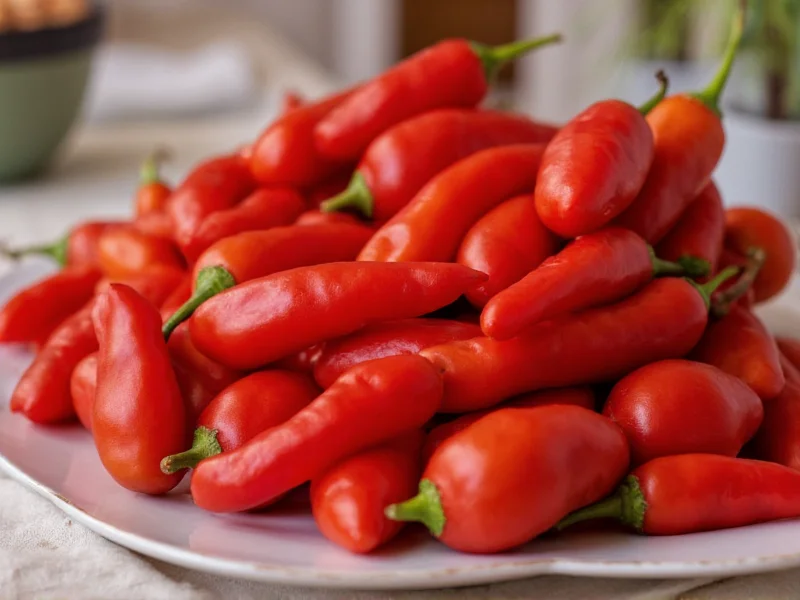Understanding the serrano chile scoville scale is essential for anyone working with fresh peppers. These vibrant green to red chilies deliver a clean, grassy heat that's become popular in Mexican cuisine and beyond. While often confused with jalapeños, serranos pack noticeably more fire while maintaining a bright, fresh flavor profile that makes them ideal for salsas, guacamole, and pickling.
What Is the Scoville Scale?
Invented by Wilbur Scoville in 1912, the Scoville scale measures chili pepper heat through capsaicin concentration. Capsaicinoids, the compounds responsible for heat, are extracted from peppers and diluted until the heat becomes undetectable to a panel of tasters. The degree of dilution determines the Scoville rating. Modern high-performance liquid chromatography (HPLC) provides more precise measurements, but the Scoville Heat Unit (SHU) remains the standard reference.
Serrano Pepper Characteristics
Originating in the mountainous regions of Mexico ("serrano" means "from the mountains"), these 1-4 inch peppers grow upright on the plant, unlike jalapeños which hang down. They transition from bright green to yellow, orange, and finally red as they mature. The thinner walls compared to jalapeños make them excellent for raw applications where you want maximum heat impact without excess bulk.
| Pepper Variety | Scoville Heat Units (SHU) | Heat Comparison |
|---|---|---|
| Bell Pepper | 0 SHU | No heat |
| Poblano | 1,000-2,000 SHU | Mild |
| Jalapeño | 2,500-8,000 SHU | Moderate |
| Serrano | 10,000-23,000 SHU | Moderate-Hot |
| Cayenne | 30,000-50,000 SHU | Hot |
| Habanero | 100,000-350,000 SHU | Very Hot |
Practical Applications of Serrano Peppers
When working with serrano chile scoville measurements, remember that heat varies within the same plant. Factors affecting serrano pepper heat level include:
- Maturity: Red serranos are typically hotter than green ones
- Growing conditions: Stress from less water increases capsaicin production
- Part of the pepper: Seeds and membranes contain the highest concentration of capsaicin
- Cultivar: Different varieties exist with varying heat profiles
Chefs appreciate serranos for their clean heat that doesn't overwhelm other flavors. They're perfect for fresh preparations where you want noticeable heat without the smokiness of chipotles or the fruitiness of habaneros. When substituting serranos for jalapeños, use approximately half the amount to maintain similar heat levels.
Safety and Handling Tips
Working with high-heat peppers like serranos requires caution. Always:
- Wear gloves when handling serrano peppers to prevent skin irritation
- Avoid touching your face, especially eyes, after handling
- Wash hands thoroughly with soap and water after preparation
- Remove seeds and membranes to reduce serrano chile heat level
- Have dairy products like milk or yogurt nearby to neutralize capsaicin if needed
Culinary Substitutions
If you need to adjust the serrano pepper scoville units in your recipe:
- Milder option: Use jalapeños (remove seeds for closer heat match)
- Similar heat: Fresh green Thai chilies work well in many applications
- Hotter option: Try red serranos or young cayenne peppers
Remember that drying peppers concentrates their heat, so one fresh serrano typically equals about 1/4 to 1/2 teaspoon of dried serrano powder, depending on the specific serrano chile scoville measurement.
Storing and Preserving Serranos
Fresh serranos keep well in the refrigerator's crisper drawer for 2-3 weeks. For longer storage:
- Freeze whole peppers in airtight containers for up to 6 months
- Pickle serranos for refrigerator storage up to 6 months
- Dry peppers by threading on string and hanging in a warm, dry place
- Roast and freeze in oil for convenient cooking use
Dried serranos develop a more complex flavor while maintaining most of their heat, making them valuable for salsas and sauces where fresh peppers aren't available.
Frequently Asked Questions
How does serrano pepper heat compare to jalapeño?
Serranos are significantly hotter than jalapeños, measuring 10,000-23,000 SHU compared to jalapeños' 2,500-8,000 SHU. A single serrano typically equals 2-3 jalapeños in heat intensity, making serrano chile scoville scale measurements important for proper substitution in recipes.
Are red serrano peppers hotter than green ones?
Yes, red serrano peppers are generally hotter than green ones. As serranos mature and change color, their capsaicin concentration increases, pushing them toward the higher end of the serrano chile scoville scale (15,000-23,000 SHU) compared to green serranos (10,000-16,000 SHU).
What's the best way to reduce serrano pepper heat?
To reduce serrano chile heat level, remove all seeds and white membranes (placenta) where capsaicin concentrates. Soaking sliced peppers in salt water or vinegar for 15-30 minutes can further reduce heat. Cooking also diminishes heat intensity, with longer cooking times resulting in milder flavor.
Can I substitute serrano peppers for jalapeños in recipes?
Yes, but adjust quantities carefully. Since serrano peppers measure higher on the scoville scale (10,000-23,000 SHU vs 2,500-8,000 SHU for jalapeños), use approximately half the amount of serranos when substituting for jalapeños. For raw applications like pico de gallo, this serrano chile heat comparison is particularly important to maintain balanced flavor.











 浙公网安备
33010002000092号
浙公网安备
33010002000092号 浙B2-20120091-4
浙B2-20120091-4